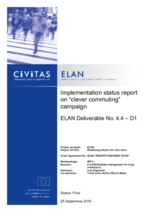Mobility management for large institutions
Summary
Zagreb has identified sustainable commuting among employees of larger organisations as one of its priorities and will promote carpooling, public transport, cycling and walking. To facilitate this transition, eight dedicated travel plans were set up for these companies.
Implementing sustainable mobility
Carpooling in Zagreb, before CIVITAS ELAN, was based on personal arrangements and no action has been taken to encourage users to see it as an innovative aspect of urban transport. Since many large systems, like business parks, hospitals, PT depots and university campuses are often located outside the city centre, long daily trips to and from work are necessary for most employees and users. Therefore, promoting carpooling scheme was one of the bigger tasks of this measure.
Progress
Data collection on the demonstration corridor of the CIVITAS ELAN project refers to following key data: modal split, vehicles number, vehicle occupancy, carpooling, etc. Surveys were carried out, focusing on areas such as the implementation and processing of survey results on mobility management. An analysis of data collected determined the needs and outlined the basis required for sustainable traffic mobility management in Zagreb.
The online survey on travelling to and from work was conducted in 23 companies in Savska cesta in April 2010 and eight target companies in October 2011. Before data was crucial in preparing transport and car-pooling plans (car-pooling scheduling) for eight companies located on the ELAN corridor. Apart from this, three research events also took place:
- Mobility management for university campus Borongaj (case study, Zagreb);
- Influence of teleworking on transport demand (case study; Zagreb);
- Study of teleworking and E- learning systems in higher education institution.
The results of these studies as well as the concept of car-pooling are presented multiple times on various public events which are organized with the cooperation of the measure leader of Comprehensive mobility dialogue and marketing.
Outcomes
- ELAN successfully implemented a carpool scheme in eight institutions despite the fact that prior to this project similar efforts were never undertaken.
- Increase in carpool arrangements. The number of carpools arrangements within the target group “employees” increased from 8 in 2009 to 36 in 2012; within the target group “students”, this number increased from 26 in 2009 to 74 in 2012. For this purpose, a car-pooling application/portal Car-for-all was developed: http://www.fpz.unizg.hr/autozasve/
- Unchanged vehicle occupancy rate. The target increase the average number of passengers in cars by 20% was not achieved mainly because 8 transport plans which were implemented could not produce such an impact that vehicle occupancy rate changes in the ELAN corridor. It could be also said that initial target was set too high.








